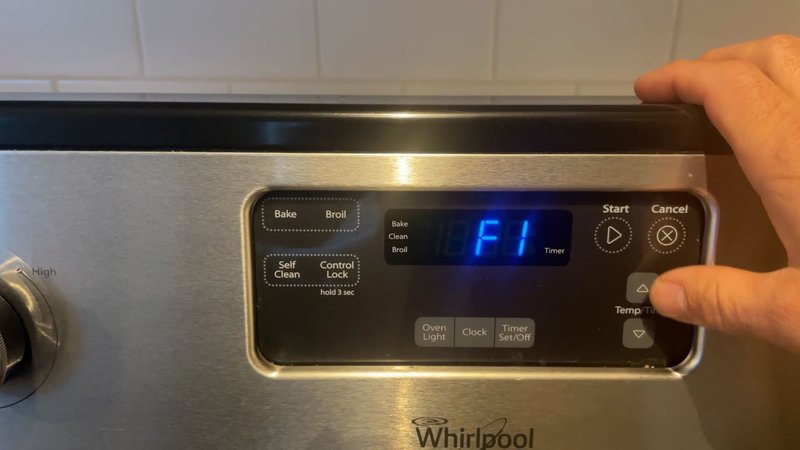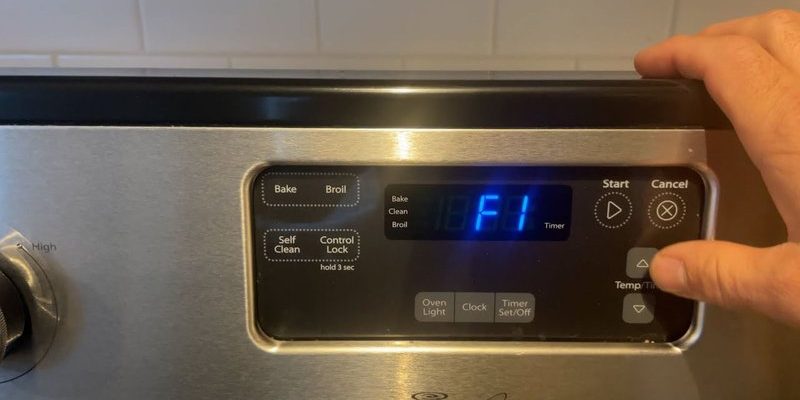
Now, let’s break it down. The F1 error code on Whirlpool microwaves is like a red flag waving at you to say there might be something amiss in the control panel. Think of it like a car’s engine light coming on—it’s not a problem you can see or hear immediately, but it’s definitely something brewing under the hood. If left unchecked, this error can eventually escalate into bigger issues, much like ignoring a leaky roof during a rainy season. But don’t worry! By the time you finish this article, you’ll not only understand what this error means but also what steps you can take next.
Understanding the F1 Error Code
You might be wondering, “What exactly does this F1 error mean?” In simple terms, it’s your microwave’s way of signaling a problem with its control panel. The control panel in a microwave acts like the brain of the appliance, directing everything from how much power is sent to the magnetron (the part that produces microwaves) to how long the timer runs. When there’s an issue with this ‘brain’, it can disrupt the entire operation of the appliance.
Think of it like your computer freezing. When your PC hangs, it might still look okay from the outside, but inside, it’s a mess of mixed-up signals. Similarly, when the F1 error pops up, it suggests a malfunction that might involve anything from a faulty keypad to issues in the circuit board. It’s a signal to check under the hood before things get worse.
Ignoring this signal could mean risking further electrical issues. Just like ignoring a blinking oil light could eventually lead to engine damage, neglecting an F1 error might result in more costly repairs down the line or even a completely non-functioning microwave. So, understanding the importance of this little code is the first step to making sure your kitchen helper stays in tip-top shape.
Common Causes of the F1 Error
So, what actually causes the F1 error? This error code can stem from several factors, each of which relates back to the central control panel. The most common culprit is a defective keypad. Over time, as we regularly use our microwaves, the keypad can wear out or become damaged, leading to miscommunications between you and your appliance. It’s like pressing the ‘A’ key on a keyboard only to have your computer type ‘B’—frustrating and confounding.
Another potential cause is internal electrical issues. Inside the microwave, numerous circuits work together to ensure everything functions smoothly. A disruption, such as a short circuit or faulty wiring, can easily trigger the F1 code. Imagine it like a single streetlight failure causing a traffic jam—one small issue can create a chain reaction of problems.
Lastly, environmental factors like excess moisture or heat can also impact the control panel. Think of it like leaving your smartphone out in the rain. Electronics and moisture don’t mix well, often leading to unpredictable behaviors. With these insights, it becomes clear why preemptively addressing the F1 error rather than ignoring it is always the wise choice.
Consequences of Ignoring the Error
Here’s the deal: choosing to ignore the F1 error can have several repercussions. Initially, you might notice minor inconveniences, such as the microwave operating intermittently or refusing to start altogether. These are just the first hints of trouble ahead. If left unresolved, further complications can arise, including potential safety hazards. Imagine ignoring a small fire in the backyard grill—it doesn’t take long for it to become uncontrollable.
As more time passes, the internal components of the microwave might suffer from further damage, which can lead to expensive repairs. Worse yet, prolonged neglect could result in having to purchase an entirely new unit. Think of it as ignoring a small crack in your windshield until it shatters completely, forcing you to replace the whole thing.
In some severe instances, electrical malfunctions can lead to more serious issues like short circuits, which might not only damage the microwave but pose a risk to your household’s electrical system. Given these potential outcomes, it’s apparent that addressing the F1 error promptly is far better than dealing with the chaos of unchecked problems.
Next Steps and Solutions
So, what should you do if your Whirlpool microwave throws up the F1 error? Start by performing a soft reset. Unplug your microwave for a few minutes, then plug it back in. It’s like rebooting your phone when it starts acting up. Sometimes, this simple act can resolve minor glitches within the control panel.
If the error persists, it’s time to delve a little deeper. Consider examining the keypad. If certain keys feel sticky or unresponsive, they might be the root of your problem. Cleaning the keypad gently with a soft, damp cloth can occasionally help. However, if the problem persists, replacing the keypad could be necessary—a task best left to appliance professionals unless you’re very comfortable tinkering with electronics.
When in doubt, it’s advisable to contact a Whirlpool service technician for a more comprehensive diagnostic and repair. After all, when it comes to dealing with electrical appliances, sometimes it’s best to leave it to the experts. In the meantime, ensuring your microwave is kept away from excess moisture and extreme temperatures can help prevent future problems.
Preventative Tips to Avoid Future Errors
To keep your Whirlpool microwave in fighting shape and avoid seeing the F1 error code in the future, a few simple maintenance tips can go a long way. First off, treat your microwave with care. Just like you wouldn’t slam a laptop shut, avoid aggressively pressing the keypad. Gentle use can significantly extend its lifespan.
Regular cleaning is important too. Grease and grime buildup can affect the touch-sensitive keypad leading to malfunctions. Clean your microwave regularly, using mild soap and water, but ensure it’s off and unplugged during the cleaning to avoid any immediate mishaps.
Lastly, place your microwave in an environment that’s conducive to its longevity. Avoid areas with high moisture, such as directly next to a stovetop, and ensure proper ventilation around the appliance. By treating your microwave like the valuable kitchen helper it is, you can significantly reduce errors and enjoy hassle-free operation for years to come.
In conclusion, while it might be tempting to ignore a little error code like F1, addressing it promptly can save you from a world of trouble in the long run. By understanding what this error means, tackling it with informed steps, and taking preventative measures, you’ll keep your microwave—and your kitchen—running smoothly.
